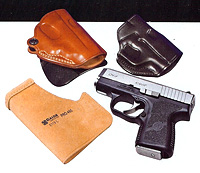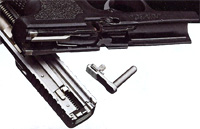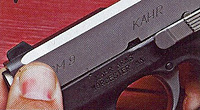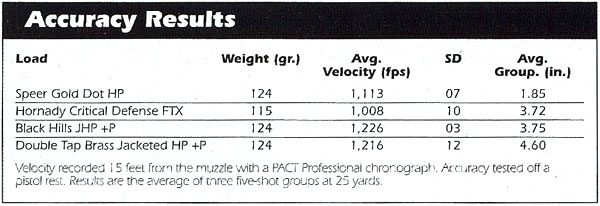- Telephone: 508-795-3919
- Contact Us
- My Account • Dealer Log In
- Technical Support • Service Shipping

THE NEXT BRAVE ONE
High quality, low cost. This is a realistic pocket gun.
Shooting Times, Personal Defense 2011, page 8~13
By Doug Larson

For concealed carry, the Kahr CM9 has the attributes of a full-size gun in a small package.
It was not long ago that most people who carried guns for a living shunned the 9mm. However, modern ammunition and bullet design have changed the minds of many, and now the 9mm has resurged as a popular self-defense round. Just as well, demand is increasing for small, easily carried and concealed handguns.
Kahr Arms of Worcester, Massachusetts, was a bit ahead of the curve when it introduced its K9 in 1995. It’s a pocket-size 9mm pistol with many features once found only in full-size pistols. The gun was a hit with law enforcement and others who carry concealed because it put useful firepower in a small package. The design evolved, others followed, and Kahr continued to develop similar guns based on that success. Eventually, in 2001 the company came out with the PM9, which was smaller than the K9 and built on a polymer frame.
The PM9 had a lot of appeal because it was much lighter than an all-steel gun and it was thin and short—about the size of a classic .32 or .380 ACP-chambered Walther PP series. Many used to consider the PPK the ultimate pocket pistol. In contrast with Walther’s blow-back operation, Kahr pistols are locked-breech, modified Browning actions, so they can better handle the more powerful 9mm in such a small package. However, due to the fact that other pocket pistols of the time were considered cheap throw-aways, many consumers didn’t realize that the most expensive PM9 wasn’t a cheap piece made from pot metal and plastic. Nevertheless, sales and demand steadily remained, but Kahr realized that another segment of the market could be reached if it could find a way to reduce the price.
There wasn’t much savings to be realized by modifying the PM9’s frame. It’s polymer, after all. However, Kahr determined that the steel slide and barrel, which required expensive machining, could be made more efficient and still offer the same attributes that attract those who continued to buy the PM9. So the engineers and designers went to work and developed the CM9.
GUN DETAILS
The CM9’s slide and barrel are made from stainless steel and have a subdued matte finish, but the slide is about 1/8 inch longer than the PM9. That is the only difference in overall dimensions I could find when comparing the two models, but there are other subtle differences.
Instead of the rounded corners found on the PM9, the CM9 slide has beveled edges along the top and front, and the front sight blade is pinned to the slide instead of drifted in a dovetail. Both carry a while dot, and both rear sights are dovetailed wearing a white post to sit the front dot on when sighting. This bar-dot sight configuration has proven to be very effective and is much better than the nearly nonexistent tiny sights found on some other guns of this size. The only other money-saving external machining that I could find was the lack of a dimple that’s cut into the front lower corner of the CM9 slide.

A variety of holsters are available from Galco, including, clockwise from bottom left, the Pocket Protector, the Speed Paddle and the Stringer. The gun is large enough that it is easy to grasp and draw without fumbling for a grip.

The slide is easily grasped by forward raking and tactile serrations.

For its intended duty as a carry piece, the magazine release is low profile enough that it doesn’t drag when the pistol is drawn. It's still easy to reach and press when needing to change magazines.

At the rear and residing inside the slide is the spring-loaded striker. Next to it, the metal protrusion is the passive striker block that is designed to prevent the striker from contacting a primer until the trigger is pulled.

For disassembly or reassembly, the slide must be retracted to this position where the slide lock can be removed or inserted past a notch cut into the bottom of the slide.

Even though the gun is small enough to easily conceal, it shoots like a full-size gun and is not difficult to control even with full-power +P 9mm loads.

The CM9 is an inexpensive version of the PM9, but handles the same way and can actually be shot for fun despite its diminutive size.
Kahr did find another subtle way to save the end user some money in doing away with the PM9’s rollmark in favor of simple engraving of the CM9 slide. It is likely that most buyers won’t care about these differences as long as the CM9 remains dependable.
Internally, the slide and barrel assembles are nearly identical to the one found on the PM9 except for the recoil-spring guide assembly, which consists of a recoil-spring guide that’s about 1/8 inch longer than the PM9’s. The spring guide telescopes and has an internal spring, all of which are surrounded by the main recoil spring. Only the outer spring can be removed for cleaning, but this has never been a problem with the several Kahr pistols I’ve tested. Instead of the PM9’s machined slide catch, which rotates freely on the shaft, the CM9’s unit is a one-piece metal injection-molded (MIM) part. This part costs less to make than the PM9’s and is another cost-saving measure that allows Kahr to offer the gun for less money.
The barrel, besides being slightly longer than the one found on a PM9, has conventional land-and-groove rifling instead of polygonal rifling. While polygonal rifling is easier to clean and is said to deliver higher velocity at the same pressure, it is more expensive to manufacture. For practical purposes, I’ve never noticed a difference between the two types of rifling, so if it means less cost for the buyer, it’s a good thing.
The barrel lug and its highly polished feed ramp are offset to the left of the boreline. This offset allows the trigger bar to run along the side of the lug instead of beneath it, which does two things. First, it allows the boreline to be set lower to the frame, which in turn results in the recoil line of thrust being lower in the hand, which reduces muzzle rise. That’s a particularly useful attribute in a small defensive sidearm because it means that the sights can be brought back on target much quicker for a follow-up shot. The other advantage that the offset lug brings is the fact that the trigger bar can be set farther inboard, making the gun slimmer. Translation: better concealability.
The CM9 is equipped with an external extractor that also served as a loaded-chamber indicator by protruding from the side of the slide when a round is chambered. It’s a nice feature, but an experienced shooter will not rely on that to make sure his gun is loaded—or unloaded. That man will instead physically check the chamber. Safety is paramount.
The steel trigger on the test gun is typical of a Kahr pistol. It has a long, smooth pull and a little stacking just before breaking cleanly at about 6-1/2 pounds. Stroking the trigger draws the striker that is already partially cocked by the action of the slide the rest of the way to the rear, where it is released to strike the primer. It’s a good draw, made so in part by the patented cocking cam. The gun is equipped with a passive striker block designed to allow the striker to move forward and hit the primer only it the trigger is pulled. Some people refer to this as a drop safety, and it’s added peace of mind since there is no external safety.
The ejector is a metal device that is fixed to the polymer frame and positively kicked expended brass well clear of the gun. The extractor and ejector work well together and functioned properly every time during testing.
To strengthen the black polymer frame and prolong the service life of the gun, the slide reciprocates on steel rails that are molded inside the dustcover and on small steel inserts at the rear of the frame rails. The grip is nicely textured on the sides and features the Kahr logo, while the front and backstraps are aggressively checkered through the mold to provide a very slip-resistant surface. This is important on a small gun with an abbreviated grip where the pinkie of the firing hands is left to dangle. The triggerguard is roomy, so there is plenty of room for beefy fingers.
The serrated magazine-release button is where Americans expect it to be—on the left side at the junction of the triggerguard and the grip. It protrudes enough that it is easy to activate and allows magazines to drop freely when pushed. Initially, empty magazines did not drop freely from the test gun, but after firing the first seven rounds, the problem went away. This illustrates why the Kahr owner’s manual recommends a 200-round break-in period.
The CM9 is supplied with one six-round stainless steel magazine with a flush baseplate and witness holes so the round count can be quickly determined. Kahr has seven-round versions with extended baseplates available that provide more gripping surface but are a little harder to conceal. The follower is polymer with a metal insert that engages the slide catch after the last round is fired, locking the slide to the rear. When a fresh magazine is inserted, the slide catch can be pushed down with the thumb, but if an empty magazine is in the gun, it is difficult to do so. This is by design, probably to signal that the gun is empty. If racking the slide is your preferred way to recharge the gun after inserting a loaded magazine—and this is the way most savvy professionals do it—the slide has plenty of gripping surface and serrations at the rear to make it work.

TAKEDOWN
Fieldstripping the CM9 is similar to other Browning modified-action guns and starts with making sure the gun is unloaded. Check it at least twice. Then, holding the slide partially to the rear so the witness marks on the left side of the frame and slide align, push the slide catch from right to left and remove it. You may need to tap the slide catch shaft with a plastic screw-driver handle to knock it free because mine was a tight fit. Next, with the gun pointed in a safe direction, pull the trigger. The slide can then be removed from the front of the frame, after which the recoil-spring assembly and barrel can be separated from the slide. The outer recoil spring is then pulled off the recoil-spring guide.
Reassembly is in reverse order, but when mating the recoil-spring assembly with the barrel and slide, be sure it is centered laterally in the slide. Because the recoil lug is offset to the slide, it can look centered when it isn’t. Also, the slide catch should be installed so that the spring in the frame pushes the catch down, not up. Otherwise the slide catch can lock the slide to the rear at a bad time.
Since my aging eyes aren’t what they used to be, to test the practical accuracy of this pistol I attached a Crimson Trace Laserguard. I’ve found that the laser aids in shooting accurately because it eliminates the need to stop and focus on the front sight while aligning it with the target and the rear sight. It also makes it easier to shoot from unusual positions, which can happen it the user is knocked off his feet in a fight and cannot quick acquire or line up the sights with his eye. Lasers are not the solution to every aiming problem, though, and even Crimson Trace will tell you that they are not a substitute for iron sights. Any mechaniacal device can fail.
As expected, the gun worked reliably well. Regardless of the load or brand, all ammunition—even +P—ran, there were no malfunctions, and recoil was never a problem. Although the CM9 is a small gun, it has enough gripping surface that it’s not uncomfortable to shoot. Testing with a variety of Galco holsters, I also found that the gun is large enough that no fumbling or searching for the grip were necessary when presenting from a belt holster or the pocket.
Kahr Arms recognizes that this gun will be used for self-defense and wisely cautions that it or any gun to be used in that way be tested with the ammunition that the user intends to carry. Kahr suggests that at least 100 rounds be tested for reliability before that brand and load are adopted for self-defense. It can be expensive to test this much ammunition, but your life is worth it. Keep in mind that the government fires thousands of rounds when evaluating new guns for police or military use.
The manufacturer’s suggested retail price is more than $200 less than that of the PM9, but it performs, functions and feels the same. I’ve put thousands of rounds through a couple of PM9s and many more through this gun, and I can see no practical difference between the two. This gun represents a great value.
<< Go back to Previous Page
